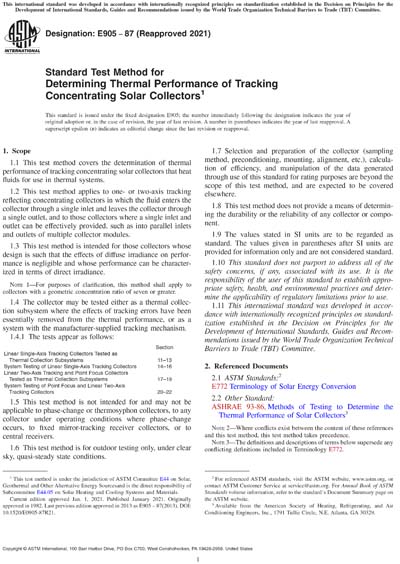Most recent
ASTM E905-87(2021)
Standard Test Method for Determining Thermal Performance of Tracking Concentrating Solar Collectors
1.1 This test method covers the determination of thermal performance of tracking concentrating solar collectors that heat fluids for use in thermal systems.
1.2 This test method applies to one- or two-axis tracking reflecting concentrating collectors in which the fluid enters the collector through a single inlet and leaves the collector through a single outlet, and to those collectors where a single inlet and outlet can be effectively provided, such as into parallel inlets and outlets of multiple collector modules.
1.3 This test method is intended for those collectors whose design is such that the effects of diffuse irradiance on performance is negligible and whose performance can be characterized in terms of direct irradiance.
Note 1: For purposes of clarification, this method shall apply to collectors with a geometric concentration ratio of seven or greater.
1.4 The collector may be tested either as a thermal collection subsystem where the effects of tracking errors have been essentially removed from the thermal performance, or as a system with the manufacturer-supplied tracking mechanism.
1.4.1 The tests appear as follows:
1.5 This test method is not intended for and may not be applicable to phase-change or thermosyphon collectors, to any collector under operating conditions where phase-change occurs, to fixed mirror-tracking receiver collectors, or to central receivers.
1.6 This test method is for outdoor testing only, under clear sky, quasi-steady state conditions.
1.7 Selection and preparation of the collector (sampling method, preconditioning, mounting, alignment, etc.), calculation of efficiency, and manipulation of the data generated through use of this standard for rating purposes are beyond the scope of this test method, and are expected to be covered elsewhere.
1.8 This test method does not provide a means of determining the durability or the reliability of any collector or component.
1.9 The values stated in SI units are to be regarded as standard. The values given in parentheses after SI units are provided for information only and are not considered standard.
1.10 This standard does not purport to address all of the safety concerns, if any, associated with its use. It is the responsibility of the user of this standard to establish appropriate safety, health, and environmental practices and determine the applicability of regulatory limitations prior to use.
1.11 This international standard was developed in accordance with internationally recognized principles on standardization established in the Decision on Principles for the Development of International Standards, Guides and Recommendations issued by the World Trade Organization Technical Barriers to Trade (TBT) Committee.
Content Provider
ASTM International [astm]






